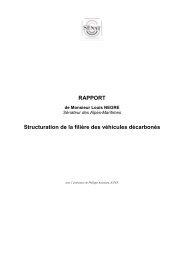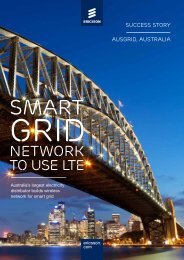Smart Choices for the Smart Grid - Smart Grids
Smart Choices for the Smart Grid - Smart Grids
Smart Choices for the Smart Grid - Smart Grids
Create successful ePaper yourself
Turn your PDF publications into a flip-book with our unique Google optimized e-Paper software.
<strong>Smart</strong> metering solutions<br />
One of <strong>the</strong> key elements of <strong>the</strong> smart grid is its capacity to support advanced metering solutions.<br />
Where a TDSO is publicly owned and can offer its own revenue-generating services (such as Internet<br />
access and IPTV services), fiber can be provided directly to customers at <strong>the</strong> access level, using<br />
technologies such as GPON that enable <strong>the</strong> installation of E<strong>the</strong>rnet-capable smart meters. TDSOs<br />
that are limited or prohibited from offering additional services may choose to use a customer’s existing<br />
broadband connection. However, TDSOs wishing to deploy a smart metering solution that relies<br />
on third-party broadband access face a number of challenges, including <strong>the</strong> fact that it is far from<br />
certain that every customer will subscribe to, or stay subscribed to, that particular third-party broadband<br />
service. As a result, it may be better to invest in wireless access networks (whe<strong>the</strong>r narrowband<br />
like 900 MHz or broadband like WiMAX) to guarantee access to smart meters.<br />
O<strong>the</strong>r options <strong>for</strong> carrying low bit rate, high-density smart metering traffic include PLC (wireline) or<br />
RF mesh over an unlicensed spectrum at 900 MHz ISM 2 and 2.4 GHz (WiFi). Technologies such as<br />
900 MHz ISM, however, are cost-effective only in high-density urban and suburban environments<br />
where signal coverage can take advantage of shorter hops between meters and/or numerous towers.<br />
As real-time demand response becomes a reality, <strong>the</strong>se low bit rate, unlicensed network systems will<br />
require migration to o<strong>the</strong>r technologies that support broadband communications (such as WiMAX<br />
and LTE). Also, as latency-sensitive, real-time telemetry control applications are deployed across <strong>the</strong><br />
distribution grid (such as syncrophasor control and o<strong>the</strong>r real-time sensors), spectrum interference in<br />
unlicensed bands or across commercial carrier networks will inhibit <strong>the</strong> deployment and usefulness of<br />
unlicensed radio systems.<br />
In addition to smart meters, buildings on <strong>the</strong> electric grid may also feature local electricity generation<br />
facilities (such as photovoltaic cells or uninterruptible power supplies) and storage facilities (<strong>for</strong> plug-in<br />
hybrid electric vehicles, <strong>for</strong> example). These facilities may be connected, along with <strong>the</strong> meter, over<br />
a local area network (LAN) or a home area network (HAN) to manage <strong>the</strong> building’s energy usage<br />
through protocols such as Zigbee and HomePlug. As buildings also gain smarter management capabilities,<br />
bandwidth needs will increase — putting pressure on 900 MHz RF and PLC technologies<br />
and accelerating <strong>the</strong> need <strong>for</strong> broadband connections directly into <strong>the</strong>se high-traffic sites.<br />
Using wireless broadband services in <strong>the</strong> access layer<br />
Many smart grid applications being deployed today can adequately operate on existing commercial<br />
wireless networks. However, out of concerns that <strong>the</strong> quality and reliability of commercial services<br />
create unjustifiable operational risk, most utilities prefer exclusive access arrangements. As an example,<br />
priority network access and priority flow management are key requirements <strong>for</strong> critical smart grid<br />
applications. To encourage widespread adoption of commercial services by TDSOs, commercial<br />
wireless providers will need to adopt <strong>the</strong> technologies necessary to permit critical utility traffic to<br />
preempt non-critical commercial traffic.<br />
United States industry regulations dictate that acceptable communication network per<strong>for</strong>mance,<br />
security and reliability requirements must be met during wide-scale power outages and <strong>the</strong> resulting<br />
‘black start’ processes <strong>for</strong> grid restoration. In <strong>the</strong> event of an extended power outage (often 72 hours<br />
or more), wireless networks will need to function independently of commercial electric service to<br />
sustain critical voice and data communications. This capability is not prevalent today in commercial<br />
wireless networks and would require significant investment in emergency power infrastructure<br />
to remediate.<br />
That being said, how should TDSOs expect wireless broadband services in <strong>the</strong> access layer to be used<br />
in order to meet <strong>the</strong> requirements and challenges associated with network reliability, availability<br />
and security?<br />
2<br />
Mesh connections between meters and <strong>the</strong>ir concentrator over unlicensed 900 MHz ISM (industrial, scientific and medicine) band<br />
in a neighborhood<br />
<strong>Smart</strong> <strong>Choices</strong> <strong>for</strong> <strong>the</strong> <strong>Smart</strong> <strong>Grid</strong> | Technology White Paper 5

















